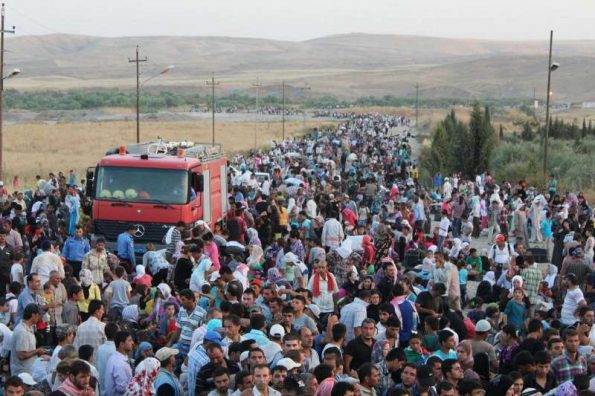
O’Donnell, Schmitter and Whitehead define transition broadly as “the interval between one political regime and another” (O´Donnell, Schmitter, and Whitehead, 1986: 6). Plattner concludes that “they emphasise a particular path to democratic transition – one that is neither violent nor revolutionary but proceeds from negotiation between an outgoing authoritarian regime and its democratic opposition and often relies upon formal pacts that provide security guarantees to both sides” (Diamond et al., 2014: 87). I wonder whether there is a common and clear pattern to democratic transition, or if rather exists a “twilight zone” in which violence is still permitted as the “vestige” of the vanishing authoritarian regime. In this brief article, I explore the connections between revolution and democracy in political changes.
|
By Dr Marco Marsili |
The Right to Change
When can a revolution be deemed “fair”? Castrén argues that if an insurgency takes on a big size, its rebels should not be treated as common criminals (Johannes and Castrén, 1966: 96-97). Walzer believes that anti-insurgents fighting against a resistance movement or a violent uprising that enjoys popular support are fighting an unjust war against the guerrilla forces (Walzer, 1977: 187). Meisels, however, doubts that popular, democratic support for an insurgency should automatically render its opposition unjust or confer legitimacy to irregular combatants (Meisels, 2006: 42). The Bolsheviks probably had the consent of the majority of the population when they overthrew the Tsar in 1917 and established a terror regime. The plebiscite held in Austria on 10 April 1938 that decided the Anschluss (unification) with Nazi Germany was a democratic exercise. Although there is no doubt that the plebiscite result was manipulated and that was held with the presence of the German troops, there was unquestionably much genuine support for an Anschluss (Kershaw, 2001: 83; Stackelberg, 2009: 170. A revolution is an illegal act that overthrows the established legal regime, most of the times accompanied by violence. Revolution is not a “slow” transition to democracy; it is a rapid and sudden change from an authoritarian regime that often enjoys popular support because it is considered “fair”. Some authors believe that violence and revolution are two sides of the same coin (Marsavelski, 2013: 394). I do not agree; not all revolutions rely on violence. To name just two that succeeded without violence: The Glorious Revolution, also called the Bloodless Revolution or Revolution of 1688, which overthrew King James II of England (James VII of Scotland) and ushered in the reign of William III and Mary II; the Carnation Revolution, a military coup in Lisbon, Portugal, on 25 April 1974, supported by massive popular participation, which ended the authoritarian regime of the Estado Novo. Revolutions gave birth to many of today’s Western democracies (see: American Revolution of 1775-1783; French Revolution of 1789; and European revolutions of 1848).
Violence and revolution constitute a frequent binomial. Man has rights until s/he is able to defend them. Marsavelski encompasses the right of revolution (jus resistendi) within the right to self-determination against alien occupation and racist regimes (2013: 247) but acknowledges that it is not an absolute right and has its limits as sui generis right (Marsavelski, 2013: 290). Maybe assassination is not a common means of democratisation but is an ancient method to put an end to tyranny. Sic semper tyrannis (“thus always to tyrants”): this phrase, said to have originated with Roman Marcus Junius Brutus during the assassination of Julius Caesar on 15 March 44 BC, was repeated two thousand years later by John Wilkes Booth after shooting to death President Lincoln.
Natural law theory provides the basis for challenging the sovereign power and to establishing positive law and government – and thus legal rights – as a derivation of the social contract. Conversely, natural rights are invoked by opponents to challenge the legitimacy of all such establishments. Grotius, who has a view of international law as natural law, rejects the possibility of justifiable use of force against the sovereign (Grotius and Barbeyrac, 1738). Hobbes thinks that the sovereign prevails over natural law, as the sovereign’s decisions need not be grounded in morality. Vattel, however, thinks that the legitimate use of revolution, evolved from the natural right of self-defence, is premised under the principle of proportionality when no other remedy can be applied to the evil (Vattel and Chitty, 1835: 20-22). Marsavelski gathers that under natural law the recognition of the right to self-defence leads to the recognition of the law of necessity (2013: 285).
In Book I of his masterpiece, The Rights of War and Peace, Grotius advances his concept of war and natural justice, arguing that there are some circumstances in which war is justifiable. In Book II, he determines three “just causes” for war: self-defence, reparation of injury and punishment. Although Grotius considers it legitimate for a nation to invade another one to overthrow a tyrant, he does not recognise the right of the oppressed to revolt.
The right to resist is also allowed by Locke. In Two Treatises of Government, the English philosopher argues that, according to the theory of social contract, people have the right to overthrow the unjust government, and to change it with one that serves the interests of citizens (§ 222 et seq.). He believes that under natural law, the people have the right to self-defence when their liberty is threatened by the local government or by a foreign nation. According to Locke, the right of revolution is a safeguard against tyranny. His contributions to liberal theory are reflected in the United States Declaration of Independence of 1776 (Becker, 1922: 27), which in its preamble proclaims the right of the people to alter or to abolish a government whenever it becomes destructive, and to replace it with a new one. The US has always recognised the right of revolution (Hackworth, 1940: 177), thus making an essential contribution to establish it in international law (Marsavelski, 2013: 271). By applying this right, US courts uphold the principle of proportionality in the use of revolutionary force, considering violence the ultimate means to overthrow the government (Dennis v. United States, 1951: 501).
The right of revolution is incorporated in the preamble of the French Constitution of the Fifth Republic (1958), which recalls the Declaration of the Rights of Man and of the Citizen of 1789. Art. 2 of the Declaration of human and civic rights states as imprescriptible the right of man to resist oppression. The preamble to the Algerian Constitution, issued after the war against France (1954-1962) that led the African country to independence, justifies the Revolution. In the First Article, the Constitution of Iran glorifies the Islamic Revolution of 1979. The right of the use of force by people to resistas ultima ratio, if no other remedy is available, is enshrined in Art. 20(4) of the Basic Law for the Federal Republic of Germany.
The preamble to the Universal Declaration of Human Rights (UDHR) speaks about the rebellion against tyranny and oppression as a last resort recourse to protect human rights. The right of colonised or oppressed peoples to free themselves is also enshrined in Art. 20(2) of the African (Banjul) Charter on Human and Peoples’ Rights (ACHP), adopted by the Organisation of African Unity (OAU) in 1981, a human rights instrument, similar to the European Convention on Human Rights (ECHR) and to the Arab Charter on Human Rights (ACHR). The ACHR is a charter adopted by the League of Arab States that affirms the principles contained in the UDHR, in the Cairo Declaration on Human Rights in Islam (CDHRI), and in the international covenants on human rights; the CDHRI is the “Islamic response” to the UDHR and was adopted by the Organisation of the Islamic Conference in 1990. The text of the CDHRI enshrines the right to the peoples oppressed or suffering from colonialism and from all forms of (What? A word is missing) and occupation have the full right to freedom and self-determination (Art. 11).
Modern constitutions refer to the sovereignty that resides/emanates from the people as the principle of democracy. Marsavelski gathers that the right to revolution is a general principle of law which exists in both international law and international customary law, even if he recognises that is not mentioned in any treaty (2013: 276-277).
Addressing the right of revolution under legal philosophy, we must consider that natural rights (ius naturale), among which is the right of revolution, intersect natural law theory, which justifies the supremacy of the strongest. According to the natural law theory (lex naturalis), certain rights are inherent by virtue of human nature endowed by nature, God, or a transcendent source, and are universal (Strauss, 1968). These binding rules of moral behaviour originate from nature’s or God’s creation of reality and mankind. For some philosophers, jurists and scholars the term natural law is equivalent to natural rights, or natural justice (Shellens, 1959), while others differentiate between natural law and natural right (Strauss, 1968).
In Leviathan, Hobbes defines natural law as “a precept, or general rule, found out by reason, by which a man is forbidden to do that which is destructive of his life, or takes away the means of preserving the same; and to omit that by which he thinks it may best be preserved” (Hobbes, 1651: 100). He believes that in the state of nature, nothing can be considered just or unjust, and every man must be considered to have a right to all things (Hobbes, 1651: XIII-13). According to the British philosopher there are nineteen Laws of nature; the first two are expounded in chapter XIV of Leviathan (“of the first and second natural laws; and contracts”), the others in chapter XV (“of other laws of nature”). The first law of nature provides states that every man may seek and use all helps and advantages of war (Hobbes, 1651: 86). The second law gives a man the right to self-defence (p. 87). The third law of nature provides the motivation to rebel against the authority: “when a covenant is made, then to break it is unjust, and the definition of injustice is no other than the not performance of covenant. Moreover, whatsoever is not unjust is just” (p. 97). The Catholic Church holds the view of natural law introduced by medieval Catholic philosophers such as Albertus Magnus (AKA Saint Albert the Great) and Thomas Aquinas. The Catholic jurisprudence draws the foundations of natural law in the Bible.
Conclusions
The foundations of the right to revolution, as a fair path to democratic change, lean on morals and ethics, as relies on controversial sources. These sources sanction, but at the same time justify, the use of violence. The concept of what is just or unjust rests on the same moral categories, which are not sufficient to justify or condemn an act, such as a revolution, as lawful or unlawful. On the other side, a strictly legal approach proves inadequate due to the unlawful nature of revolution. An act can be unjust, but not unlawful, and can be just, although unlawful.
References
African (Banjul) Charter on Human and Peoples’ Rights, adopted on 27 June 1981, entered into force on 21 October 1986, OAU Doc. CAB/LEG/67/3 rev. 5, 21 ILM. 58 (1982).
Arab Charter on Human Rights (ACHR), adopted on 22 May 2004, reprinted in 12 Int’l Hum. Rts. Rep. 893 (2005), entered into force on 15 March 2008.
Basic Law for the Federal Republic of Germany of 23 May 1949.
Becker, C. L. (1922). The Declaration of Independence: A study in the History of Political Ideas (Vol. 60). Harcourt: Brace.
Constitution of the Islamic Republic of Iran, adopted by referendum on 2-3 December 1979.
Constitution of the People’s Democratic Republic of Algeria of 1989, reinstated on 28 November 1996, and modified in 2002 and 2008.
Convention for the Protection of Human Rights and Fundamental Freedoms, as amended by Protocols no. 11 and no. 14, signed in Rome on 4 November 1950 and entered into force on 3 September 1953, ETS 5; 213 UNTS 221.
De Vattel, E., and Chitty, J. (1835). The Law of Nations: or, Principles of the Law of Nature, Applied to the Conduct and Affairs of Nations and Sovereigns. PH Nicklin & T. Johnson.
Declaration of the Rights of Man and of the Citizen of 26 August 1789 (Declaration of Human and Civic Rights).
Dennis v. United States, 341 U.S. 494 (1951), § 501.
Diamond, L. et al., (2014). Reconsidering the Transition Paradigm, Journal of Democracy, 25(1), 86-100.
Grotius, H. and Barbeyrac, J. (1738). Of a War made by Subjects against their Superiors, In The Rights of War and Peace: In Three Books, Book 1. Edited by W. Innys and R. Manby, J. and P. Knapton, D. Brown, T. Osborn, and E. Wicksteed.
Hackworth, G. H. (1940). Digest of International Law (Vol. 2). US Government Printing Office.
Hobbes, T. (1651). Leviathan, or the Matter, Forme, & Power of a Common-Wealth Ecclesiasticall and Civill. London: A. Crooke.
Johannes E. and Castrén, S. (1966). Civil War. Helsinki: Suomalainen Tiedeakatemia.
Kershaw, I. (2001). Hitler 1936-1945: Nemesis. London: Penguin.
Marsavelski, A. (2012). The Crime of Terrorism and the Right of Revolution in International Law. Conn. J. Int’l L., 28, 243.
Meisels, T. (2006). The Trouble with Terror: The Apologetics of Terrorism: A Refutation. Terrorism and Political Violence, 18(3), 465-483.
O’Donnell, G., Schmitter, P. C., & Whitehead, L. (1986). Transitions from Authoritarian Rule: Prospects for Democracy, Baltimore: John Hopkins University Press.
Shellens, M. S. (1959). Aristotle on Natural Law. Nat. LF, 4(1), 72-100.
Stackelberg, R. (2009). Hitler’s Germany: Origins, Interpretations, Legacies. London: Routledge.
Strauss, L. (1968). Natural Law, In International Encyclopaedia of the Social Sciences. London: Macmillan.
The International Bill of Human Rights
UNGA, Resolution 217 A [Universal Declaration of Human Rights], adopted on 10 December 1948 at the Palais de Chaillot, Paris.
Walzer, M. (1977). Just and Unjust Wars. New York: Basic Books.
To Download the PDF, click here…



